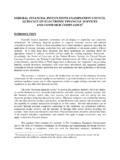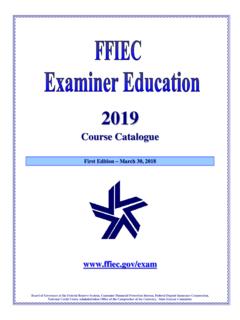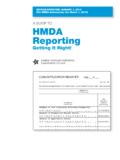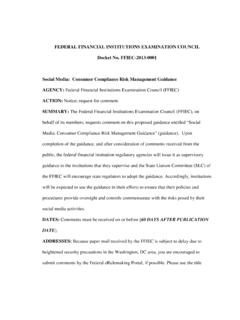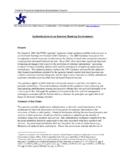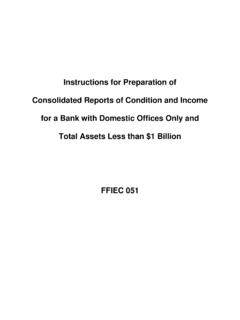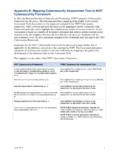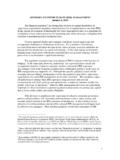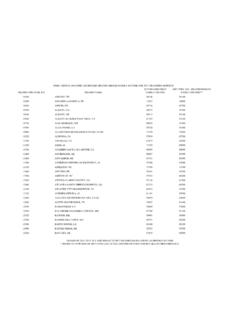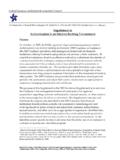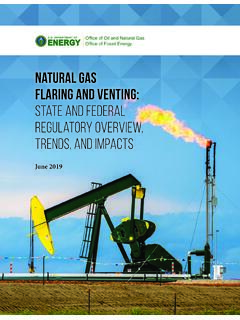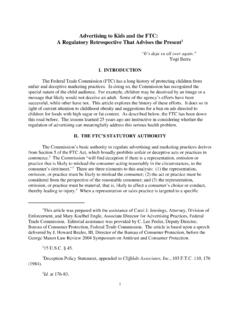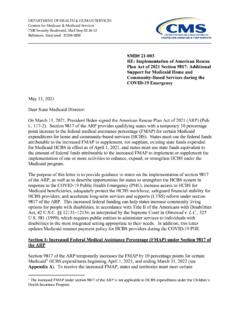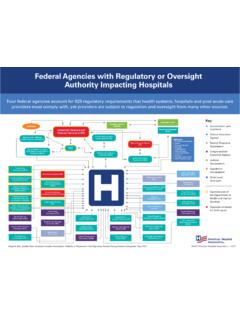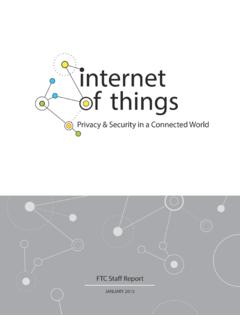Transcription of FFIEC Guidance on Electronic Financial Services and ...
1 1 federal Financial INSTITUTIONS EXAMINATION COUNCILGUIDANCE ON Electronic Financial SERVICESAND CONSUMER COMPLIANCE1 INTRODUCTIONF ederally insured depository institutions are developing or employing new electronictechnologies for delivering Financial products to improve customer service and enhancecompetitive positions. Some of those institutions have asked regulators questions regarding theapplication of existing consumer protection laws and regulations to Electronic product deliverymethods. It is clear from these questions that these institutions are uncertain about theappropriate manner to address Electronic Services under the existing regulatory framework. Accordingly, the Board of Governors of the federal Reserve System, the federal DepositInsurance Corporation, the National Credit Union Administration, the Office of the Comptrollerof the Currency, and the Office of Thrift Supervision (collectively, the Agencies )
2 Are providingfederally insured depository institutions with some basic information and suggested guidancepertaining to federal consumer protection laws and regulations and their application to electronicfinancial service issuance is intended to assess the implications of some of the emerging electronictechnologies for the consumer regulatory environment, to provide institutions with an overview ofpertinent regulatory issues, and to offer suggestions on how to apply existing consumer laws andregulations to new Electronic Financial Services . The term Electronic Financial service as used in this Guidance includes, but is not limitedto, on-line Financial Services , Electronic fund transfers, and other Electronic payment systems. On-line Financial Services , stored value card systems, and Electronic cash are among the newelectronic products being introduced in the market.
3 Financial institutions are establishing Internetweb sites that advertise products and Services , accept Electronic mail, and provide consumers withthe capability to conduct transactions through an on-line system. Services and products can beaccessed through personal computers connecting to the institution via proprietary software,commercial on-line Services , and the Internet, or through other access devices including, forexample, video kiosks and interactive television. Financial institutions should be advised that manyof the general principles, requirements, and controls that apply to paper transactions may alsoapply to Electronic Financial Guidance letter contains two sections: 1) The Compliance regulatory Environment,and 2) The Role of Consumer Compliance in Developing and Implementing Electronic relating to compliance issues are used for illustrative purposes.
4 Institutions are 1 This document does not serve as an Official Staff Commentary or shield institutions that comply with thisguidance from civil liability for violations under the various statutes to use the concepts underlying these examples when implementing an electronicservices technology plan. It should be understood that existing consumer laws and regulationsgenerally apply to applicable transactions, advertisements and other Services conductedelectronically. It should also be understood, however, that not all of the consumer protectionissues that have arisen in connection with new technologies are specifically addressed in thisguidance. Additional communiqu s may be issued in the future to address other aspects ofconsumer laws and regulations as the Financial service environment regulatory ENVIRONMENTThis section summarizes and highlights the most recent changes in the relevant sections offederal consumer protection laws and regulations that address Electronic Financial Services , andnotes other relevant provisions of law.
5 This information is not intended to be a complete checklistfor consumer compliance in the Electronic medium. It does not address a number of open issuessurrounding the application of consumer rules to new Electronic Financial Services that arecurrently being considered by the appropriate agencies. It is critical that institutions providingelectronic delivery mechanisms develop and maintain an in-depth knowledge of the relevantstatutes and regulations. Moreover, it should be kept in mind that additional changes to relevantlaws and regulations arising in response to the new Electronic service technologies may occur. The rapid development of technology and new products will require updating of this , the regulatory requirement that disclosures be in writing and in a form thecustomer can keep has been met by providing paper disclosures to the customer.
6 For example, abank would supplement Electronic disclosures with paper disclosures until the regulations havebeen reviewed and changed, if necessary, to specifically allow Electronic delivery of disclosures. Some of the consumer regulations were reviewed and changed to reflect Electronic disclosures. These changes are summarized in this section. Also, attached to this Guidance is a matrix entitled Compliance Issues Involving Electronic Services that highlights some of the principalcompliance issues that should be considered by Financial institutions when developing andimplementing Electronic SERVICESE lectronic Fund Transfer Act (Regulation E)Generally, when on-line banking systems include Electronic fund transfers that debit orcredit a consumer s account, the requirements of the Electronic Fund Transfer Act and RegulationE apply.
7 A transaction involving stored value products is covered by Regulation E when thetransaction accesses a consumer s account (such as when value is loaded onto the card from theconsumer s deposit account at an Electronic terminal or personal computer).In accordance with , Financial institutions must provide disclosures that are clearand readily understandable, in writing, and in a form the consumer may keep. An Interim rule was3issued on March 20, 1998 that allows depository institutions to satisfy the requirement to deliverby Electronic communication any of these disclosures and other information required by the actand regulations, as long as the consumer agrees to such method of delivery. According to the federal Reserve Board Official Staff Commentary (OSC) (a)-4, Financial institutions must ensure that consumers who sign-up for a new banking service areprovided with disclosures for the new service if the service is subject to terms and conditionsdifferent from those described in the initial disclosures required under Although notspecifically mentioned in the commentary, this applies to all new banking Services includingelectronic Financial Services .
8 The OSC also clarifies that terminal receipts are unnecessary for transfers initiated on-line. Specifically, OSC (h)-1 provides that, because the term Electronic terminal excludes atelephone operated by a consumer, Financial institutions need not provide a terminal receipt whena consumer initiates a transfer by a means analogous in function to a telephone, such as by apersonal computer or a facsimile , OSC (b)-5 clarifies that a written authorization for preauthorizedtransfers from a consumer s account includes an Electronic authorization that is not signed, butsimilarly authenticated by the consumer, such as through the use of a security code. According tothe OSC, an example of a consumer s authorization that is not in the form of a signed writing butis, instead, similarly authenticated is a consumer s authorization via a home banking system.
9 Tosatisfy the regulatory requirements, the institution must have some means to identify the consumer(such as a security code) and make a paper copy of the authorization available (automatically orupon request). The text of the Electronic authorization must be displayed on a computer screenor other visual display that enables the consumer to read the communication from the institution. Only the consumer may authorize the transfer and not, for example, a third-party merchant onbehalf of the to , timing in reporting an unauthorized transaction, loss, or theft of anaccess device determines a consumer s liability. A Financial institution may receivecorrespondence through an Electronic medium concerning an unauthorized transaction, loss, ortheft of an access device.
10 Therefore, the institution should ensure that controls are in place toreview these notifications and also to ensure that an investigation is initiated as in Savings Act (Regulation DD) Financial institutions that advertise deposit products and Services on-line must verify thatproper advertising disclosures are made in accordance with all provisions of Institutionsshould note that the disclosure exemption for Electronic media under (e) does notspecifically address commercial messages made through an institution s web site or other on-linebanking system. Accordingly, adherence to all of the advertising disclosure requirements of is required. Advertisements should be monitored for recency, accuracy, and compliance. Financial4institutions should also refer to OSC (b)-2(i) if the institution s deposit rates appear onthird party web sites or as part of a rate sheet summary.
